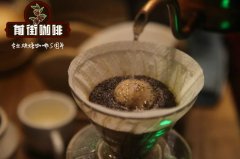Why is Brazilian coffee popular? Where does Brazil produce the most coffee? Brazilian coffee drinking method

Professional coffee knowledge exchange more coffee bean information please follow the coffee workshop (Wechat official account cafe_style)
Although Brazilian coffee accounts for 30% to 35% of the world's annual output, ranking first in the world, it is a pity that no Brazilian bean can be called state-of-the-art coffee. Compared with the elevations of other coffee-producing countries in Central and South America, Brazil is mostly about 600 to 1000 meters above sea level, and even South Minas, Serrado and Mojiana rarely exceed 1300 meters.
There are many kinds of Brazilian coffee, it is difficult to say what extra flavor it has, no outstanding advantages, no significant disadvantages, most of them are medium acid, taste lubrication, mainly mild and smooth, mellow and sweet, its softness makes it mixed with other coffee beans, the taste will not change much; and the oil is rich in contrast. So Brazilian coffee beans are best mixed with other coffee beans to make espresso, which forms a golden foam on the surface of espresso and gives the coffee a slightly sour taste and a long finish.
Brazil is one of the countries with the most abundant freshwater resources, but the distribution of water resources is uneven, and many areas rely on natural draught. In the east where coffee cultivation is concentrated, drought often occurs, and water resources limit the way coffee is processed. There is a big difference in quality when rough solarization was used before 1990. The quality revolution was carried out in the 1990s, and the half-sun method was vigorously promoted. The half-sun method inherits the advantages of the sun method to improve the sweetness and enhance the fruit aroma and sweetness.
Brazilian coffee also carries a lot of weight in the world, providing nearly 45% of the world's coffee raw beans. The length of the country's dry season may even affect coffee prices around the world.
Brazilian coffee is widely grown in flat areas. In order to adapt measures to local conditions, Brazilian landlords have developed improved Arabica coffee trees that do not require highland or shade decades ago, which can be planted on plains or grasslands and directly exposed to the sun, which is different from the traditional higher altitude shade cultivation.
Most of the Brazilian coffee gardens are only a few hundred meters above sea level, even on flat land. This kind of exposure planting method makes the coffee fruit grow faster, the flavor development is not complete, and the density of beans, that is, the so-called hardness is not as good as plateau beans, the acidity of the fruit is obviously low, the flavor is monotonous, and the coastal Rio coffee even has iodine and salty taste. This flavor is thought to be the result of some kind of microbial action, but even if it is planted in the same soil, it does not necessarily produce this flavor every year. Most coffee hobbies do not appreciate this flavor. Only a few Middle Eastern countries have the habit of sugar and brewing coffee, which is particularly suitable for the flavor of Rio coffee.
Seven of the states in Brazil produce the most, accounting for 98% of the country's total output.
State of Sao Paulo (Mogiana, Centro-Oeste)
State of Parana (Norte Pionerio do Paran á)
Bahia State (Planaltoda Bahia, Cerrado da Bahia, Atlantico Baiano)
Espiritu Santo (Montanhas do Esp í rito Santo, Conilon Capixaba)
Minas Gerais State (Sul de Minas, Cerrado Mineiro, Chapada de Minas, Matas de Minas)
Londonia (Rond?nia)
Rio de Janeiro State (Rio de Janeiro)
END
Important Notice :
前街咖啡 FrontStreet Coffee has moved to new addredd:
FrontStreet Coffee Address: 315,Donghua East Road,GuangZhou
Tel:020 38364473
- Prev

What kind of Latin American coffee do you have? Introduction to Starbucks Honduran Coffee Wash Makala Coffee
Professional coffee knowledge exchange more coffee bean information please follow the coffee workshop (Wechat official account cafe_style) the refreshing and lively acidity of Latin America, with nutty, cocoa and soft spice flavors. Honduras is a very beautiful country and occupies an important position in the history of Central America. Until around 900 AD, the ancient city of Copan Maya
- Next

How about Yemeni coffee? Is the Yemeni mocha coffee good? How do you make mocha coffee?
Coffee workshop (Wechat official account cafe_style) Coffee is from Ethiopia, but it was medieval Yemen that helped coffee reach out to the world and become everyone's daily must-have drink. According to the historical records of the World Coffee Research Organization (WCR), coffee appeared as a drink for the first time in human history.
Related
- Detailed explanation of Jadeite planting Land in Panamanian Jadeite Manor introduction to the grading system of Jadeite competitive bidding, Red bid, Green bid and Rose Summer
- Story of Coffee planting in Brenka region of Costa Rica Stonehenge Manor anaerobic heavy honey treatment of flavor mouth
- What's on the barrel of Blue Mountain Coffee beans?
- Can American coffee also pull flowers? How to use hot American style to pull out a good-looking pattern?
- Can you make a cold extract with coffee beans? What is the right proportion for cold-extracted coffee formula?
- Indonesian PWN Gold Mandrine Coffee Origin Features Flavor How to Chong? Mandolin coffee is American.
- A brief introduction to the flavor characteristics of Brazilian yellow bourbon coffee beans
- What is the effect of different water quality on the flavor of cold-extracted coffee? What kind of water is best for brewing coffee?
- Why do you think of Rose Summer whenever you mention Panamanian coffee?
- Introduction to the characteristics of authentic blue mountain coffee bean producing areas? What is the CIB Coffee Authority in Jamaica?

